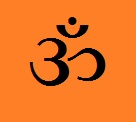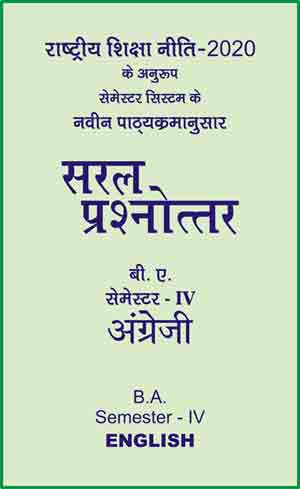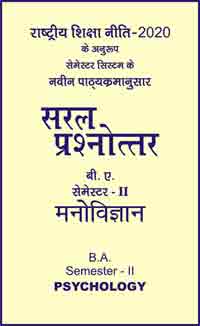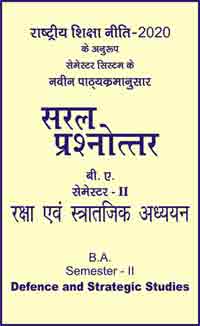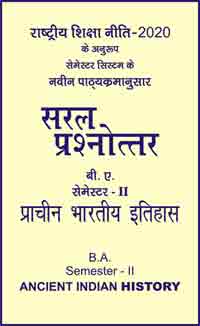|
बी ए - एम ए >> बीए सेमेस्टर-4 अंग्रेजी बीए सेमेस्टर-4 अंग्रेजीसरल प्रश्नोत्तर समूह
|
5 पाठक हैं |
|||||||
बीए सेमेस्टर-4 अंग्रेजी - सरल प्रश्नोत्तर
Chapter - 9 Mahasweta Devi : The Hunt
Brief Introduction
Mahasweta Devi's story 'The Hunt' centres around the animal hunting festival, the most popular myth of the tribals of Bihar. The original title in Bengali is "Shikar" which means the hunt. Explaining the contest of the myth, Devi writes in the story, "Once there were (wild) animals in the forest, life was wild, the hunt game had meaning." In this sense the myth marked the protection of the entire tribe and its environment from the destructive animals. The tradition, however, is kept up long after it had lost its relevance.
The myth informs the central theme of the story. Tehsildar Singh a greedy mainstream contractor lands in the quiet village of Kuruda with intentions of felling and carrying away the giant sal trees in Prasadji's estate of seventy five acres of land.
The tribals interest and well being at once of man and nature is represented by Mary Oraon, who embodies the intelligence of the west and the love of the tribals. She puts her intelligence to the best use and tries to counsel Prasadji and other village head men, but to no avail. She explains to Prasadji that the contractor had tricked him and would get the sals at throw away price and would sell them to the timber merchants at an exhobitant rate by cubic foot. Prasadji is misled by his son and other village mirazdars like Lalchand and Mulni.
Though the government of India has passed laws declaring illegal the felling of trees in forest regions the government machinery is so corrupt that the illegal action never comes to light. Thus the happening in Kuruda are representative of what happens in the whole of India. Events in the short story, the writer declares are authentic, including the character of Mary. She says she has actually seen her and heard her life history from the songs of the tribes. Thus the story combines the particular and the representative.
The tribals are blamed for deforestation. One of the village elders explains to Mary. "If I said 'No', the villagers would go wild. The; would say who gives us this kind of money?" In her own life, once a tribal told Mahasweta Devi, "I need five rupees a day to buy rice. Ask me to fell a tree, I'll do it unwillingly, but I'll do it.
Tehsildar Singh in the story is the representative of the mainstream power that exploits the poor workers as well as the earth. The myth of hunt game is rehearsed through Mary Oraon, who like Mother Earth is also viewed by the contractor as an object to be exploited. She identifies him as the wild 'animal'. She takes law into her own hands and dispenses justice by killing him on the festival day. At the end, she walks "fearless as she has killed the biggest beast".
Thus the myth gets well intergrated with the present day tribal life. The story promotes awareness among the powers that be, that because of their negligence, deforestation goes on undeterred. Government should intervene and prevent deforestation on war footing and the tribals should be educated and guaranteed a minimum standard of living and purposeful engagements, if the land and its people are to remain secure and protected from degeneration.
Important Facts to Remember
Mahasweta Devi (1926-2016) is one the foremost writers in Bengali. Devi was an ardent fighter and her weapons were fiction and her political writings. Her impressive body of work includes novels, short stories, children's stories, plays and activist prose that she published between 1981 and 1992. She was one of the prominent writers and worked for the rights of the low class people, especially the tribal people. She made immense contribution towards communities of landless labourers of eastern India where she worked for years. Her intimate connection with these communities allowed her to understand and begin documenting grassroots- level issues, thus making her a socio-political commentator of the marginalized community. The Hunt by Mahasweta Devi exposes of how the tribal people are closely living with the nature, which is providing each and everything for them, and can easily survive with forest and animals because nature is the world for them. Without nature, these people cannot survive in the world. The characters of Mahasweta Devi are landless labourers, tribal and poor people and women, which are the prominent one in her writings. She was the only one who described the word counter, which means killing by police encounter and also description for the death of police torture, which are still happening in the society.
Mahasweta Devi's story The Hunt centers around the animal hunting festival, the most popular myth of the tribals of Bihar. The original title in Bengali is Shikar which means the hunt. Devi writes in the story, “Once there were (wild) animals in the forest, life was wild, the hunt game had meaning." In this sense the myth marked the protection of the entire tribe and its environment from the destructive animals. The tradition, however, is kept up long after it had lost its relevance.
Mahasweta Devi, an Indian Bengali writer is famous for her stories which are more often than not women centric. In her stories we come across situations in which women are subjugated and exploited either by their family members or by authoritative and influential figures or by the enforcers of law. Mahasweta Devi highlights the fact that women's lives are full of struggles as they are more vulnerable because of their physicality. Honoured with the Padma Vibhushan and several literary awards like the Sahitya Akademi Award, Jnanpith Award and Ramon Magsaysay Award,
Mahasweta Devi was a stalwart of the tribal communities. She dedicated her life for the rights and empowerment of the tribal communities. Her works have been translated into English by Gayatri Chakravorty Spivak.
'The Hunt' by Mahasweta Devi was published in an anthology called Imaginary Maps. It is the story of a young girl, Mary Oraon who is the offspring of Bhikni, a tribal woman and Dixon, a white man. Mary is an attractive eighteen year old girl who works hard to earn her livelihood. She is confident, strong and knows how to keep unwanted male attention at bay.
'The Hunt' is a remarkable story in its own right. It brings to light how mainstream authoritative figures like Tehsildar Singh seek to take advantage of the subalterns. However, it is different in its treatment of the theme of subjugation as it showcases the protagonist not as a victim who is wronged but as a survivor who fights all odds and takes control of her life. Mary transgresses gender roles and emerges as a strong, independent woman. Her quest for identity finally comes to a fruitful end when she decides to elope with Jalim. 'The Hunt' may be regarded as a microcosm for the macrocosm ... a mirror that reflects the transformation in gender roles in the contemporary society. "The story thus becomes a celebration of traditions that is compellingly relevant in contemporary times as well." (Gupta 24) An avant-garde writer, Mahasweta Devi through this story, inspires women to take charge of their own lives and no longer cater to the stereotypical image of a 'damsel in distress.
'The Hunt' forms part of a collection published as Imaginary Maps: Three Stories by Mahasweta Devi in 1995. The other two stories in the collection are namely Douloti the Bountiful' and 'Pterodactyl, Puran Sahay, and Pirtha.' All three stories describe a fictional rendition of situations that are very real in the lives of the tribal people. While 'The Hunt' is about a half tribal girl's bold attempt to put a violent end to her personal exploitation as well as to the threat of ecological devastation, 'Douloti' deals with the problem of bonded labour, particularly the women who are exploited endlessly and mercilessly through the system. The heart wrenching image at the end of the story with Douloti's rotting and bleeding body covering the map of India raises many disturbing questions and speaks volumes for what independent India has failed to do for one sixth of its population. In Devi's words "Decolonization has not reached the poor. That is why these things happen. Women are just merchandize, commodities." In the third and concluding story 'Pterodactyl' Devi attempts to show 'what has been done to the entire tribal world of India.' As the author says: "If read carefully, 'Pterodactyl' will communicate the agony of the tribals, of marginalized people all over the world, ".
Two of the stories in the above collection are women centric. In fact when we read Devi's other fiction we find that many of her stories revolve around women where she highlights women's subordination, their vulnerability and their extreme exploitation, be it in middle class households, in tribal villages or in brickfields. Yet, she refuses to be labeled a feminist. She proclaims that she writes as a writer and not as a woman and looks at a problem in its entirety and not just at its gender aspect. Her tales åre powerful tales of exploitation as well as struggle where a woman is more vulnerable simply because of the physical disadvantage of being a woman. More often than not the women in her stories though intrinsically strong and resilient, are often left with no choice but to succumb to their circumstances. Against this backdrop, 'The Hunt' comes as a breath of fresh air where Mary Oraon, the beautiful half white half tribal girl has the courage and determination to take matters in her own hands and put an end not only to her own oppression but also to a threat to her entire community.
The events of the story revolve around Mary Oraon, a half tribal girl who works for the estate owner Mr. Prasad at the Dixon Bungalow. Everything seems to be going smoothly until the day Tehsildar Singh lands in the village, being invited by Banwari Lal, Mr. Prasad's son, for negotiating a deal regarding the giant Sal trees on Prasad's estate. Not only does he eye the Sal he even begins lusting after Mary the moment he sets eyes on her. Mary is angry and rebuffs his advances without much success. On the day of Jani Parab, the annual hunting festival, Mary ultimately resorts to violence to put an end to the matter by hunting down Tehsildar. Rather than being a passive victim of male sexual aggression she avenges her oppressive plight by killing her assailant.
Mahasweta Devi shares her thoughts and ideas on the tribal people through works and speaks of how they are living in the forest and how they are closely connected with the nature, because nature is the mother of them. Without nature, the people cannot survive in the world. Food of the nature is very healthy and can eradicate the diseases because food is the medicine. As the text lines will be an apt to discuss the above concept. "The Sobors will be forgiveness if they are forced to fell a tree: You are our friend. I do this because my wife doesn't have any food, my son doesn't have any food, my daughter starves. Before they killed an animal, they used to pray to the animals: the bird, the fish, the deer".
In The Hunt, she negotiates the difference between the ancient time and the modern time, which are changing from time to time due to globalization. The following lines will be an evidence to remember the above idea. "As long as the forests were there, the hunting tribes did not suffer so much, because the forests used to provide them with food, shelter, timber, hunting. But now that the forests are gone, the tribals are in dire distress".
The tribal people are the bonded labourers due to the loss of land and also becoming slaves. In order to survive, they are suppressed by the land lords and could not get proper wages even for the food. So, they are forced to the critical situation of poverty by the land lords. No one is ready to help for them even from the government side also. Mahasweta Devi exactly points out the reasons for poverty and sufferings through her work. As the text lines will be exact for talking of those problems. "Nothing is done for them although so much money is allotted for them. They do not want money; they want facilities; they want to live the life of an honourable poor Indian, you might say. But they are denied everything".
The Hunt written by Mahasweta Devi exposes not only the problems of tribal people but also the grief of writer because she is the crusader of the tribal people and sacrifices her life for them. Mahasweta describes that the tribal people are more civilized than others. The Hunt conveys that the tribal people are not against anything, but they could not live freely and facing lot of problems. So, Devi focuses her views to unite them, but not ready to accept her and ignored by the government. She speaks of her bitter experience from the government side through this work. When the people unite with others, they will share each and everything, including the food, because they all suffer together during the time of drought. The readers can know the reality of the government, which is never ready to accept the unity of the people. "In 1986, I formed the Adim Jati Aikya Parishad [ Tribal Unity Forum] in desperation. The Government is angry at this, at the uniting of the tribes. I have to hammer and hammer upon this".
The Hunt deliberates that how the system condemns the tribal people as criminals and face all the problems because suppression and oppression are playing vital roles in the society. Mahasweta Devi longs for individual freedom, compassion, justice, and equality. In this world, there are lots of problems happening for various reasons, but they will not punish mostly and blame the tribal people for all the problems, because they are easily victims for the crime, and can blame them that they are suffering even for the food. As the text lines deliberate the truth of writer and can know the reason for demanding the justice. "All over the world. Do these tribes commit all these crimes? They are your easy victims, they are your prey, you hunt them. The system hunts them. And wants to brand them. The system which hunts them and uses as target is the criminal”.
In The Hunt, Mahasweta Devi expresses that the pathetic condition of the children, who could not live with pleasure and they are starving and killing even for the food. The tribal children are not securable and suffering by the dominant society, because no one comes forward for them. They easily became slaves for the capitalist market, which mostly demands child from the tribal society. "In the capitalist market there is great demand for children, especially tribal children. You pay them little; you can starve them; you can kill them; no one will come for them".
Mahasweta Devi speaks of the difference between men and women. The women could not survive due to inequality of the society, and they are suppressed by the men and also tortured for various problems. The women are easily victims for men, and also dominated by them. In The Hunt, Mahasweta reveals that the women could not live freely and oppressed by the men. When they go to work with men, they will not get proper wages, and tolerate the sufferings for their life and ready to work for the food. As the text lines will be clear to speak of the issues. "Money at home. Others will fell the trees, twelve annas daily for men, eight annas for women for trimming branches and carrying the pieced timber to the tracks. And a tiffin of cornmeal in the afternoon. Unbelievable! Salt and cayenne with the meal".
Through this work The Hunt, the readers can understand reality of the world, which gives more importance for the religion rather than human values. Mahasweta Devi narrates her keen observation on the tribal woman through the character of Mary, who is the protagonist of the work and also a tribal girl and could not live peacefully because of a woman. She faces sufferings due to patriarchal society and could not get the food easily. Ideas of the writer are practical and also reality, which are culled out through an experience of the life. The text lines will be clear to discuss of the religious problem.
In The Hunt, Mahasweta deals with the social evils, which are inevitable in the world, especially for women, who can eradicate all the problems and also can protect themselves with the help of bravery. In the end of the work, Mary finally hunts the big beast, by whom she faces lot of problems. The big beast is none other than Tehsildar, who pursues her for his desire, and she hunts him for food, because nature provides so many things like fruits, vegetables, food, wood and so on. In the forest, they can get food easily and also can live with pleasure.
Mahasweta Devi's story ?The Hunt? centres around the animal hunting festival, the most popular myth of the tribals of Bihar. The original title in Bengali is Shikar? which means the hunt. Explaining the contest of the myth, Devi writes in the story,? Once there were (wild) animals in the forest, life was wild, the hunt game had meaning.? (p 12) In this sense the myth marked the protection of the entire tribe and its environment from the destructive animals. The tradition, however, is kept up long after it had lost its relevance.
The myth informs the central theme of the story.
|
|||||




